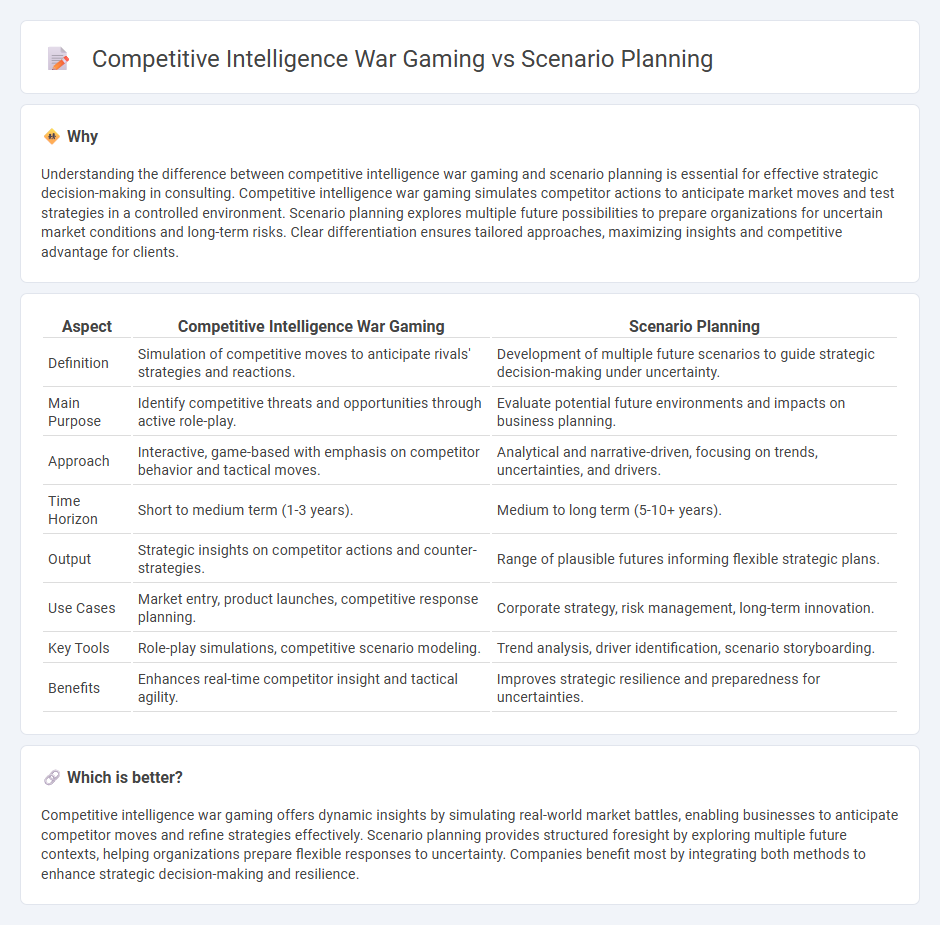
Competitive intelligence war gaming simulates market scenarios and competitive moves to identify strategic risks and opportunities, enhancing decision-making under uncertainty. Scenario planning explores multiple future landscapes by modeling diverse external factors, allowing organizations to prepare flexible strategies. Discover how integrating these methodologies can sharpen your strategic foresight and competitive edge.
Why it is important
Understanding the difference between competitive intelligence war gaming and scenario planning is essential for effective strategic decision-making in consulting. Competitive intelligence war gaming simulates competitor actions to anticipate market moves and test strategies in a controlled environment. Scenario planning explores multiple future possibilities to prepare organizations for uncertain market conditions and long-term risks. Clear differentiation ensures tailored approaches, maximizing insights and competitive advantage for clients.
Comparison Table
| Aspect | Competitive Intelligence War Gaming | Scenario Planning |
|---|---|---|
| Definition | Simulation of competitive moves to anticipate rivals' strategies and reactions. | Development of multiple future scenarios to guide strategic decision-making under uncertainty. |
| Main Purpose | Identify competitive threats and opportunities through active role-play. | Evaluate potential future environments and impacts on business planning. |
| Approach | Interactive, game-based with emphasis on competitor behavior and tactical moves. | Analytical and narrative-driven, focusing on trends, uncertainties, and drivers. |
| Time Horizon | Short to medium term (1-3 years). | Medium to long term (5-10+ years). |
| Output | Strategic insights on competitor actions and counter-strategies. | Range of plausible futures informing flexible strategic plans. |
| Use Cases | Market entry, product launches, competitive response planning. | Corporate strategy, risk management, long-term innovation. |
| Key Tools | Role-play simulations, competitive scenario modeling. | Trend analysis, driver identification, scenario storyboarding. |
| Benefits | Enhances real-time competitor insight and tactical agility. | Improves strategic resilience and preparedness for uncertainties. |
Which is better?
Competitive intelligence war gaming offers dynamic insights by simulating real-world market battles, enabling businesses to anticipate competitor moves and refine strategies effectively. Scenario planning provides structured foresight by exploring multiple future contexts, helping organizations prepare flexible responses to uncertainty. Companies benefit most by integrating both methods to enhance strategic decision-making and resilience.
Connection
Competitive intelligence war gaming and scenario planning are interconnected tools used in consulting to anticipate market shifts and competitor moves by simulating real-world scenarios and strategic responses. War gaming leverages competitive intelligence to create dynamic, interactive simulations that test strategies against potential competitor actions, enhancing decision-making under uncertainty. Scenario planning complements this by outlining multiple plausible futures, enabling consultants to develop flexible strategies that are resilient across diverse market conditions.
Key Terms
Scenario Planning:
Scenario planning involves creating diverse, plausible future environments to anticipate potential challenges and opportunities, enhancing strategic decision-making under uncertainty. It systematically examines external factors like market trends, technological advancements, and geopolitical shifts to build flexible strategies. Explore more to understand how scenario planning can future-proof your organization's strategy.
Foresight
Scenario planning creates multiple future contexts to identify potential challenges and opportunities, enhancing strategic foresight. Competitive intelligence war gaming simulates adversarial moves and market dynamics to test responses and improve decision-making agility. Explore in-depth distinctions and applications to sharpen your foresight capabilities.
Contingency
Scenario planning explores multiple future environments to address uncertainties and develop flexible strategies, while competitive intelligence war gaming simulates specific competitive interactions to anticipate rivals' actions and test tactical responses. Contingency in scenario planning emphasizes preparing adaptive strategies for diverse possible futures, whereas war gaming focuses on real-time decision-making under pressure based on competitors' moves. Explore deeper insights into how these approaches enhance organizational resilience and strategic advantage.
Source and External Links
What is Scenario Planning and How to Use It - SME Strategy - Scenario planning involves identifying key driving forces and critical uncertainties to develop four plausible future scenarios for strategic discussion and decision-making, enhancing preparedness for various business environments.
Scenario Planning - American Planning Association - Scenario planning is a decision-support process that helps planners anticipate multiple plausible futures by analyzing current conditions, forecasts, and influential factors, enabling adaptive and resilient strategies.
Scenario Planning: Strategy, Steps and Practical Examples - NetSuite - Scenario planning allows organizations to proactively identify assumptions about the future and develop responses for different potential outcomes, increasing readiness for both risks and opportunities.
 dowidth.com
dowidth.com